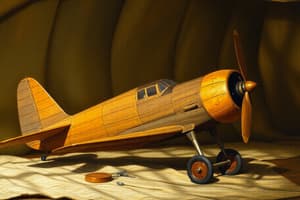Podcast
Questions and Answers
Why was weight a primary factor in the Wright Flyer's design?
Why was weight a primary factor in the Wright Flyer's design?
- Lightweight materials were easier to source and work with given the limited technology available.
- Heavier materials were more expensive at the time, making lightweight options more cost-effective.
- Lightweight materials allowed for greater speed and maneuverability, crucial for early flight experiments. (correct)
- The focus on lightweight materials was primarily for aesthetic reasons, as the Wright brothers prioritized appearance.
What was the main purpose of applying oils and finishes to the early woven fabric coverings of aircraft?
What was the main purpose of applying oils and finishes to the early woven fabric coverings of aircraft?
- To protect the fabric from the elements and prevent sagging. (correct)
- To increase the fabric's flexibility for easier manipulation during construction.
- To enhance the fabric's color and provide a more appealing visual appearance.
- To reduce the fabric's weight, further improving the aircraft's performance.
What was the primary advantage of using nitrate dope on aircraft fabric in 1916?
What was the primary advantage of using nitrate dope on aircraft fabric in 1916?
- Enhanced ability to repel water and prevent mildew growth.
- Reduced weight compared to earlier fabric treatments.
- Improved fabric adhesion, tautness, and protection. (correct)
- Increased resistance to impacts and tears during flight.
Why was butyrate dope eventually combined with nitrate dope for aircraft fabric treatment?
Why was butyrate dope eventually combined with nitrate dope for aircraft fabric treatment?
What sequence of applying nitrate and butyrate dopes to aircraft fabric was found to be most effective, and why?
What sequence of applying nitrate and butyrate dopes to aircraft fabric was found to be most effective, and why?
Flashcards
Fabric Covering (Wright Flyer)
Fabric Covering (Wright Flyer)
Light weight material used to cover the wood frame of the Wright Flyer.
Organic Aircraft Fabric
Organic Aircraft Fabric
Finely woven material, like Irish linen, used as a fabric.
Fabric Sag
Fabric Sag
Caused fabric to sag when exposed to elements, leading to the use of protective oils and finishes.
Nitrate Dope (1916)
Nitrate Dope (1916)
Signup and view all the flashcards
Butyrate Dope
Butyrate Dope
Signup and view all the flashcards
Study Notes
- The Wright flyer used a fabric-covered wood frame.
- Using fabric provides the advantage of light weight.
- The disadvantages of using fabric are poor durability and flammability.
- Finely woven organic fabrics, like Irish linen, tended to sag, exposing the structure to the elements.
- Builders started using oils and finishes to protect the fabric.
- In 1916, nitrite dope became available to make fabric adhere, taut, and protect it.
- However, nitrite dopes had the extreme flammability.
- Butyrate dope was determined to be less flammable
- This second type of dope did not adhere well.
- Eventually the two dopes were combined.
- First nitrate was applied then butyrate.
Studying That Suits You
Use AI to generate personalized quizzes and flashcards to suit your learning preferences.




